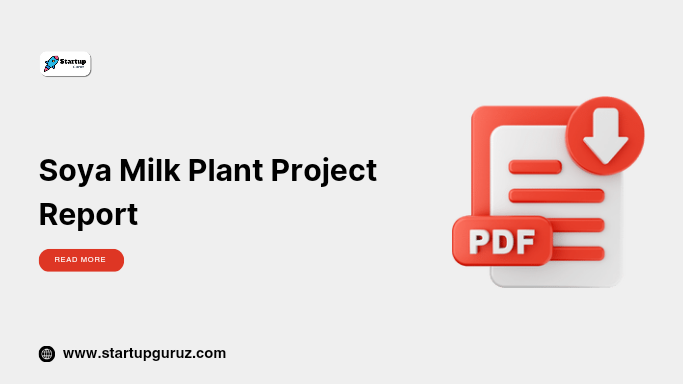Soya Milk Plant Project Report
Soya Milk Plant Project Report
A soya milk plant is a profitable and eco-friendly business idea due to the growing demand for plant-based alternatives to dairy products. With rising health consciousness and dietary shifts, soya milk has gained significant popularity. This project report aims to provide a comprehensive guide for starting a soya milk manufacturing unit, covering business potential, market analysis, setup requirements, and financials.

Importance of a Soya Milk Plant Project Report
A project report is essential when applying for loans or seeking investors. It provides a clear roadmap for setting up and running the business, highlighting the financial viability, market potential, and operational requirements.
Key Benefits:
- Loan Approval: Demonstrates financial feasibility and profitability to lenders.
- Business Planning: Helps streamline operations and resource allocation.
- Market Insights: Provides a detailed analysis of market trends and consumer behavior.
- Risk Mitigation: Identifies potential risks and strategies to mitigate them.
Components of a Soya Milk Plant Project Report
1. Executive Summary
- Overview of the business idea.
- Project goals and objectives.
- Funding requirements.
2. Business Description
- Product: Soya milk, flavored soya milk, and other derivatives like tofu and soya yogurt.
- Target Audience: Health-conscious individuals, lactose-intolerant consumers, and vegans.
- USP: Nutritional benefits, eco-friendliness, and cost-effectiveness.
3. Market Analysis
- Demand Trends: Rising preference for plant-based milk globally and in India.
- Competitors: Established brands like Silk, Sofit, and niche local players.
- Opportunities: Increasing urbanization, awareness about lactose intolerance, and affordability compared to traditional dairy products.
4. Production Process
The production of soya milk involves the following steps:
- Cleaning: Sorting and cleaning of soybeans.
- Soaking: Beans are soaked in water for hydration.
- Grinding: Hydrated beans are ground into a fine paste.
- Extraction: Separation of liquid (soya milk) from the pulp (okara).
- Pasteurization: Heating to eliminate harmful microorganisms.
- Packaging: Filling the milk into cartons, bottles, or pouches.
5. Plant Setup Requirements
Machinery and Equipment
| Equipment | Estimated Cost (₹) |
|---|---|
| Soybean grinder and separator | 3,50,000 – 5,00,000 |
| Boiler and pasteurizer | 4,00,000 – 6,00,000 |
| Packaging machine | 2,00,000 – 3,50,000 |
| Storage tanks | 1,50,000 – 2,50,000 |
| Miscellaneous tools | 1,00,000 – 2,00,000 |
Infrastructure Requirements
- Area: 1,000 to 1,500 square feet.
- Utilities: Water supply, electricity, and drainage systems.
- Licenses: FSSAI certification, GST registration, pollution control clearance, and trade license.
6. Raw Materials and Suppliers
- Soybeans: Sourced from local farmers or suppliers.
- Packaging Material: Cartons, pouches, or bottles.
- Flavors and Additives: Chocolate, vanilla, or other natural flavors.
Financial Projections for a Soya Milk Plant
Setup Costs
| Expense Item | Estimated Cost (₹) |
|---|---|
| Machinery and equipment | 12,00,000 – 18,00,000 |
| Infrastructure and setup | 5,00,000 – 8,00,000 |
| Initial raw materials | 2,00,000 – 3,00,000 |
| Licenses and approvals | 1,00,000 – 1,50,000 |
| Miscellaneous expenses | 1,50,000 – 2,50,000 |
| Total Setup Cost | 21,50,000 – 33,00,000 |
Revenue and Profit Projections
- Monthly Production: 10,000 liters of soya milk.
- Revenue per Month: ₹5,00,000 – ₹7,50,000.
- Net Profit Margin: 20-25%.
- Break-even Period: 12-18 months.
Marketing and Sales Strategies
1. Distribution Channels
- Supermarkets and grocery stores.
- Online platforms like Amazon and Flipkart.
- Local distributors and retail outlets.
2. Branding and Advertising
- Highlight health benefits and eco-friendliness.
- Use social media platforms for promotions.
- Partner with nutritionists and dieticians to recommend the product.
3. Pricing Strategy
- Competitive pricing to attract customers initially.
- Discounts and offers for bulk purchases.
Risk Analysis
Potential Risks:
- Raw Material Availability: Dependence on soybean harvests.
- Market Competition: Presence of established brands.
- Operational Challenges: Machinery breakdowns or labor shortages.
Mitigation Strategies:
- Build strong relationships with reliable suppliers.
- Invest in high-quality machinery for efficient operations.
- Diversify product offerings to include tofu or soya yogurt.
FAQs
1. What is a soya milk plant project report?
It is a comprehensive document outlining the business plan, market analysis, financial projections, and operational requirements for starting a soya milk plant.
2. Why is soya milk in demand?
Soya milk is popular due to its health benefits, affordability, and suitability for vegans and lactose-intolerant individuals.
3. How much does it cost to set up a soya milk plant?
The total setup cost ranges from ₹21,50,000 to ₹33,00,000, depending on the scale and location.
4. What licenses are required for a soya milk plant?
Licenses include FSSAI certification, GST registration, pollution control clearance, and a trade license.
5. What are the key raw materials for soya milk production?
The primary raw materials are soybeans, water, packaging materials, and natural flavors or additives.
6. What is the profitability of a soya milk plant?
With a net profit margin of 20-25%, the business can break even within 12-18 months.
7. How is soya milk marketed?
It is marketed through supermarkets, online platforms, local distributors, and targeted social media campaigns.
8. Can I add flavored soya milk to my product line?
Yes, flavored variants like chocolate and vanilla are highly popular and can increase sales.
9. What are the common risks in this business?
Risks include raw material shortages, market competition, and operational challenges.
10. Is a soya milk plant eco-friendly?
Yes, soya milk production has a lower environmental footprint compared to dairy milk.
Conclusion
Starting a soya milk plant is a lucrative business opportunity in the growing plant-based food sector. A well-prepared project report is crucial for securing loans and planning operations. By focusing on quality, branding, and efficient production, entrepreneurs can establish a successful and sustainable business.